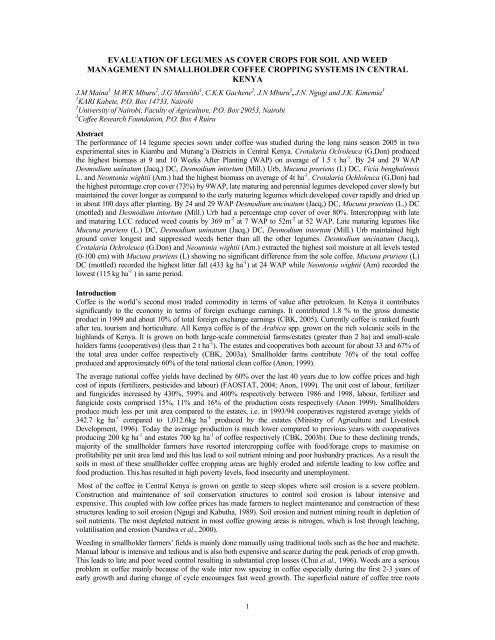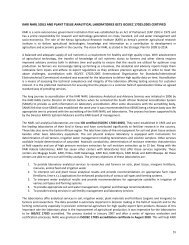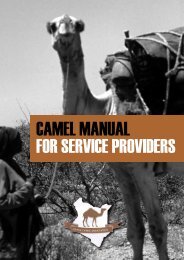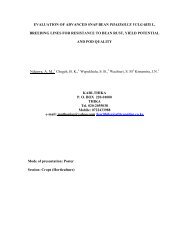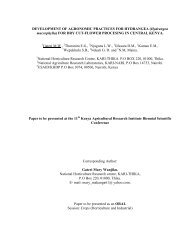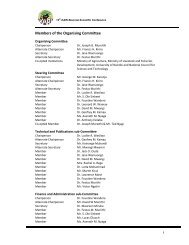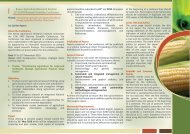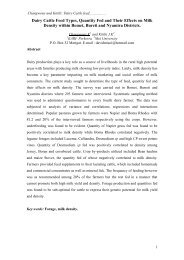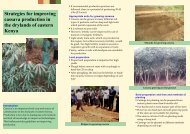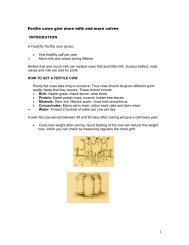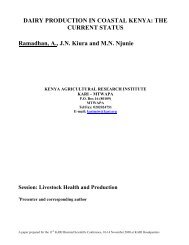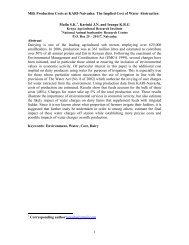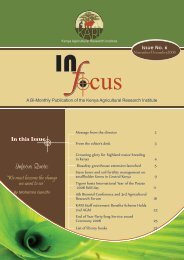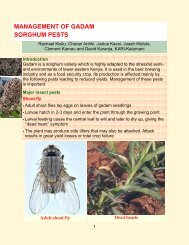Evaluation of legumes as cover crops for soil - Kenya Agricultural ...
Evaluation of legumes as cover crops for soil - Kenya Agricultural ...
Evaluation of legumes as cover crops for soil - Kenya Agricultural ...
You also want an ePaper? Increase the reach of your titles
YUMPU automatically turns print PDFs into web optimized ePapers that Google loves.
EVALUATION OF LEGUMES AS COVER CROPS FOR SOIL AND WEED<br />
MANAGEMENT IN SMALLHOLDER COFFEE CROPPING SYSTEMS IN CENTRAL<br />
KENYA<br />
J.M Maina 1 , M.W.K Mburu 2 , J.G Mureithi 1 , C.K.K Gachene 2 , J.N Mburu 3 , J.N. Ngugi and J.K. Kimemia 3<br />
1 KARI Kabete, P.O. Box 14733, Nairobi<br />
2 University <strong>of</strong> Nairobi, Faculty <strong>of</strong> Agriculture, P.O. Box 29053, Nairobi<br />
3 C<strong>of</strong>fee Research Foundation, P.O. Box 4 Ruiru<br />
Abstract<br />
The per<strong>for</strong>mance <strong>of</strong> 14 legume species sown under c<strong>of</strong>fee w<strong>as</strong> studied during the long rains se<strong>as</strong>on 2005 in two<br />
experimental sites in Kiambu and Murang’a Districts in Central <strong>Kenya</strong>. Crotalaria Oclroleuca (G.Don) produced<br />
the highest biom<strong>as</strong>s at 9 and 10 Weeks After Planting (WAP) on average <strong>of</strong> 1.5 t ha -1 . By 24 and 29 WAP<br />
Desmodium uninatum (Jacq,) DC, Desmodium intortum (Mill.) Urb, Mucuna pruriens (L) DC, Vicia benghalensis<br />
L. and Neontonia wightii (Arn.) had the highest biom<strong>as</strong>s on average <strong>of</strong> 4t ha -1 . Crotalaria Ochloleuca (G.Don) had<br />
the highest percentage crop <strong>cover</strong> (73%) by 9WAP, late maturing and perennial <strong>legumes</strong> developed <strong>cover</strong> slowly but<br />
maintained the <strong>cover</strong> longer <strong>as</strong> compared to the early maturing <strong>legumes</strong> which developed <strong>cover</strong> rapidly and dried up<br />
in about 100 days after planting. By 24 and 29 WAP Desmodium uncinatum (Jacq,) DC, Mucuna pruriens (L.) DC<br />
(mottled) and Desmodium intortum (Mill.) Urb had a percentage crop <strong>cover</strong> <strong>of</strong> over 80%. Intercropping with late<br />
and maturing LCC reduced weed counts by 369 m -2 at 7 WAP to 52m -2 at 52 WAP. Late maturing <strong>legumes</strong> like<br />
Mucuna pruriens (L.) DC, Desmodium uninatum (Jacq,) DC, Desmodium intortum (Mill.) Urb maintained high<br />
ground <strong>cover</strong> longest and suppressed weeds better than all the other <strong>legumes</strong>. Desmodium uncinatum (Jacq,),<br />
Crotalaria Ochroleuca (G.Don) and Neoutonia wightii (Arn.) extracted the highest <strong>soil</strong> moisture at all levels tested<br />
(0-100 cm) with Mucuna pruriens (L) showing no significant difference from the sole c<strong>of</strong>fee. Mucuna pruriens (L)<br />
DC (mottled) recorded the highest litter fall (433 kg ha -1 ) at 24 WAP while Neontonia wightii (Arn) recorded the<br />
lowest (115 kg ha -1 ) in same period.<br />
Introduction<br />
C<strong>of</strong>fee is the world’s second most traded commodity in terms <strong>of</strong> value after petroleum. In <strong>Kenya</strong> it contributes<br />
significantly to the economy in terms <strong>of</strong> <strong>for</strong>eign exchange earnings. It contributed 1.8 % to the gross domestic<br />
product in 1999 and about 10% <strong>of</strong> total <strong>for</strong>eign exchange earnings (CBK, 2005). Currently c<strong>of</strong>fee is ranked fourth<br />
after tea, tourism and horticulture. All <strong>Kenya</strong> c<strong>of</strong>fee is <strong>of</strong> the Arabica spp. grown on the rich volcanic <strong>soil</strong>s in the<br />
highlands <strong>of</strong> <strong>Kenya</strong>. It is grown on both large-scale commercial farms/estates (greater than 2 ha) and small-scale<br />
holders farms (cooperatives) (less than 2 t ha -1 ). The estates and cooperatives both account <strong>for</strong> about 33 and 67% <strong>of</strong><br />
the total area under c<strong>of</strong>fee respectively (CBK, 2003a). Smallholder farms contribute 76% <strong>of</strong> the total c<strong>of</strong>fee<br />
produced and approximately 60% <strong>of</strong> the total national clean c<strong>of</strong>fee (Anon, 1999).<br />
The average national c<strong>of</strong>fee yields have declined by 60% over the l<strong>as</strong>t 40 years due to low c<strong>of</strong>fee prices and high<br />
cost <strong>of</strong> inputs (fertilizers, pesticides and labour) (FAOSTAT, 2004; Anon, 1999). The unit cost <strong>of</strong> labour, fertilizer<br />
and fungicides incre<strong>as</strong>ed by 430%, 599% and 400% respectively between 1986 and 1998, labour, fertilizer and<br />
fungicide costs comprised 15%, 11% and 16% <strong>of</strong> the production costs respectively (Anon 1999). Smallholders<br />
produce much less per unit area compared to the estates, i.e. in 1993/94 cooperatives registered average yields <strong>of</strong><br />
342.7 kg ha -1 compared to 1,012.6kg ha -1 produced by the estates (Ministry <strong>of</strong> Agriculture and Livestock<br />
Development, 1996). Today the average production is much lower compared to previous years with cooperatives<br />
producing 200 kg ha -1 and estates 700 kg ha -1 <strong>of</strong> c<strong>of</strong>fee respectively (CBK, 2003b). Due to these declining trends,<br />
majority <strong>of</strong> the smallholder farmers have resorted intercropping c<strong>of</strong>fee with food/<strong>for</strong>age <strong>crops</strong> to maximise on<br />
pr<strong>of</strong>itability per unit area land and this h<strong>as</strong> lead to <strong>soil</strong> nutrient mining and poor husbandry practices. As a result the<br />
<strong>soil</strong>s in most <strong>of</strong> these smallholder c<strong>of</strong>fee cropping are<strong>as</strong> are highly eroded and infertile leading to low c<strong>of</strong>fee and<br />
food production. This h<strong>as</strong> resulted in high poverty levels, food insecurity and unemployment.<br />
Most <strong>of</strong> the c<strong>of</strong>fee in Central <strong>Kenya</strong> is grown on gentle to steep slopes where <strong>soil</strong> erosion is a severe problem.<br />
Construction and maintenance <strong>of</strong> <strong>soil</strong> conservation structures to control <strong>soil</strong> erosion is labour intensive and<br />
expensive. This coupled with low c<strong>of</strong>fee prices h<strong>as</strong> made farmers to neglect maintenance and construction <strong>of</strong> these<br />
structures leading to <strong>soil</strong> erosion (Ngugi and Kabutha, 1989). Soil erosion and nutrient mining result in depletion <strong>of</strong><br />
<strong>soil</strong> nutrients. The most depleted nutrient in most c<strong>of</strong>fee growing are<strong>as</strong> is nitrogen, which is lost through leaching,<br />
volatilisation and erosion (Nandwa et al., 2000).<br />
Weeding in smallholder farmers’ fields is mainly done manually using traditional tools such <strong>as</strong> the hoe and machete.<br />
Manual labour is intensive and tedious and is also both expensive and scarce during the peak periods <strong>of</strong> crop growth.<br />
This leads to late and poor weed control resulting in substantial crop losses (Chui et al., 1996). Weeds are a serious<br />
problem in c<strong>of</strong>fee mainly because <strong>of</strong> the wide inter row spacing in c<strong>of</strong>fee especially during the first 2-3 years <strong>of</strong><br />
early growth and during change <strong>of</strong> cycle encourages f<strong>as</strong>t weed growth. The superficial nature <strong>of</strong> c<strong>of</strong>fee tree roots<br />
1
makes the plant vulnerable to weed competition <strong>for</strong> moisture (Akobundu 1987). Weeds have been shown to depress<br />
c<strong>of</strong>fee yields and quality (Jones and Wallis 1963.<br />
Weeds have been cited <strong>as</strong> a major problem in c<strong>of</strong>fee in this country with weeds depressing c<strong>of</strong>fee yields by 50% and<br />
above (Njoroge and Kimemia, 1990). Most emph<strong>as</strong>is on weed research in <strong>Kenya</strong> h<strong>as</strong> been on mechanical and<br />
chemical weed control. These 2 methods <strong>of</strong> weed control are expensive <strong>for</strong> most <strong>of</strong> the smallholder farmers who are<br />
struggling with the poor c<strong>of</strong>fee prices which h<strong>as</strong> caused a lot <strong>of</strong> poverty and food insecurity in their are<strong>as</strong>. Research<br />
on use <strong>of</strong> <strong>cover</strong> <strong>crops</strong> <strong>as</strong> a means <strong>of</strong> weed control in c<strong>of</strong>fee in <strong>Kenya</strong> is lacking. Growing green manure legume<br />
<strong>cover</strong> <strong>crops</strong> (GMLCC) <strong>as</strong> part <strong>of</strong> the smallholder c<strong>of</strong>fee cropping system can play an important role in improving<br />
<strong>soil</strong> fertility, reduce <strong>soil</strong> erosion and control weeds in c<strong>of</strong>fee farms (Kimemia, 1998). Integration <strong>of</strong> high yielding<br />
green manure <strong>legumes</strong> can incre<strong>as</strong>e plant nutrient supply in the <strong>soil</strong> especially nitrogen and improve <strong>soil</strong> physical<br />
properties (Mureithi et al., 2003). Legumes can also provide good ground <strong>cover</strong> minimising <strong>soil</strong> erosion through<br />
raindrop impact and run<strong>of</strong>f (Gachene and Haru, 1997). Some GMLCC are a source <strong>of</strong> food (Veesteeg et al., 1998)<br />
and fodder (Njarui et al., 2000), an important attribute especially in the high population density are<strong>as</strong> with zero<br />
grazing dairy production systems (Ngugi and Kabutha, 1989).<br />
The aim <strong>of</strong> the study w<strong>as</strong> to evaluate several LCC in c<strong>of</strong>fee to come up with the best bets that can be used in these<br />
cropping systems. The evaluation w<strong>as</strong> being carried in a participatory farm approach method by the farmers,<br />
researchers and agricultural extension staff. The first stage <strong>of</strong> the project involved a stakeholders meeting, Rapid<br />
Rural Appraisal (RRA) and Participatory Rural Appraisal (PRA). These activities aimed at: Bringing together all the<br />
stakeholders involved in the project; Gathering in<strong>for</strong>mation to add to existing knowledge on smallholder c<strong>of</strong>fee<br />
production and other cropping systems; Assessing the current condition, <strong>of</strong> <strong>soil</strong>, water and weed management and<br />
the farmers copping strategies; Contributing to the design <strong>of</strong> the evaluation study to be carried on farms fields.<br />
Materials and Methods<br />
Study team<br />
The study w<strong>as</strong> conducted by a multi-disciplinary research team from <strong>Kenya</strong> <strong>Agricultural</strong> Research Institute,<br />
University <strong>of</strong> Nairobi and C<strong>of</strong>fee Research Foundation and <strong>Agricultural</strong> Extension staff <strong>of</strong> Murang’a District.<br />
Study sites<br />
The field work w<strong>as</strong> carried out in 3 divisions in Murang'a District which is a major c<strong>of</strong>fee growing area in the Mt<br />
<strong>Kenya</strong> region.<br />
Socio-economic survey<br />
The socio-economic survey involved a stakeholders meeting, Rapid Rural Appraisal (RRA) and Participatory Rural<br />
Appraisal ( PRA).<br />
Stakeholders meeting<br />
This w<strong>as</strong> a one day meeting. It w<strong>as</strong> held at the beginning <strong>of</strong> the project in February 2005. This meeting brought<br />
together and linked up the researchers, agricultural extension <strong>of</strong>ficers, farmers and NGO's working in agricultural<br />
related activities in the District<br />
Rapid Rural Appraisal (RRA)<br />
This activity w<strong>as</strong> carried out after the stakeholders meeting by the Researchers and Ministry <strong>of</strong> agriculture extension<br />
staff. The RRA w<strong>as</strong> done along a transect across the agro-ecological zones (UM1, UM2 & UM3) where c<strong>of</strong>fee is<br />
grown. During the RRA the group had a chance to meet some farmers chosen at random in the different AEZ. They<br />
were interviewed by the group using a questionnaire.<br />
Participatory Rural Appraisal (PRA)<br />
The PRA meetings were conducted with a group <strong>of</strong> farmers in the are<strong>as</strong> where work w<strong>as</strong> to be done after the RRA.<br />
During the PRA meetings the farmers were introduced to the researchers, and the agricultural extension staff who<br />
were going to work with them. It w<strong>as</strong> an open <strong>for</strong>um where the farmers were able to talk about the different<br />
cropping systems they practice in the area and also on socio-economic and agronomic factors affecting them and<br />
in<strong>for</strong>mation on their coping strategies. During these meetings the farmers selected the contact farmers among them<br />
and give on-farm evaluation sites. A questionnaire w<strong>as</strong> used to guide the meeting.<br />
On farm evaluation trials<br />
The trials were carried out in Murang'a District in all the three divisions i.e. Mathioya, Kangema and Kahuro. These<br />
divisions also represented the 3 agro-ecological zones i.e. UM1, UM2 & UM3 . Each site had 3 contact farmers<br />
selected during the PRA meeting giving a total <strong>of</strong> 9 contact farmers. The experimental design w<strong>as</strong> completely<br />
randomised block design researcher designed and farmer managed. There were 15 plots each me<strong>as</strong>uring 5 m by<br />
2.7m. Each farm had 15 treatments and each farmer w<strong>as</strong> a replicate in each agro-ecological zone.<br />
2
Treatment names<br />
� Lablab purpureus (Dolichos Rongai)<br />
� Crotalaria ochroleuca (sunhemp)<br />
� Desmodium intoticum (green leaf)<br />
� Control (c<strong>of</strong>fee alone)<br />
� Ph<strong>as</strong>eolus vulgaris (common bean KK8)<br />
� Ph<strong>as</strong>eolus vulgaris (common bean KK22)<br />
� Glycine max (TGX 1893-10F)<br />
� Ph<strong>as</strong>eols lunatus (Butter bean)<br />
� Mucuna pruriens (Mucuna white)<br />
� Canavalia ensi<strong>for</strong>mis (Jack bean)<br />
� Vigna unguiculata (Cowpea K80)<br />
� Desmodium uncinatum (Silver leaf)<br />
� Mucuna pruriens (Mucuna mottled)<br />
� Neontonia wightii<br />
� Glycine max (TGX 1871-12E)<br />
Data collection<br />
Soil samples were collected randomly from each site at the beginning <strong>of</strong> experiment. The samples were taken from<br />
0-15 cm and 15-30 cm depth from five points in each site then bulked. This w<strong>as</strong> done in all the farms 3 weeks after<br />
planting (WAP). Weed counts and identification w<strong>as</strong> done at 3 WAP and 9 WAP. This w<strong>as</strong> done by placing<br />
randomly a quadrat <strong>of</strong> 0.25 m 2 in each plot twice. Weeds in each plot were identified and rated by species using a<br />
scale <strong>of</strong> 1 - 4 i.e.<br />
0 = no weeds 1 = 1 weed 2 = 2 - 5 weeds<br />
3 = 6 - 20 4 = over 20 weeds<br />
After counting the weeds, in each quadrat they were harvested at <strong>soil</strong> level, dried and weighed. Time taken to weed<br />
in each plot w<strong>as</strong> recorded. This is being done at different stages <strong>of</strong> crop growth using a ceptometer and also bead<br />
method procedure.<br />
The treatments were <strong>as</strong>signed randomly to each plot in each farm. Planting w<strong>as</strong> done during 2 nd week <strong>of</strong> April 2005<br />
following recommended agronomic practices. Data on <strong>soil</strong>s, weed growth, LCC growth and their effect on weed<br />
growth, and weeding labour were recorded.<br />
Results and Discussions<br />
Socio-economic survey<br />
During the socio-economic survey several factors were cited <strong>as</strong> the causes <strong>of</strong> high poverty levels, low c<strong>of</strong>fee and<br />
crop yields and a decline in <strong>soil</strong> fertility in the smallholder c<strong>of</strong>fee farms in this region. These were:<br />
� Lack <strong>of</strong> extension support in regard to <strong>soil</strong> conservation me<strong>as</strong>ures.<br />
� High levels <strong>of</strong> poverty due to lack <strong>of</strong> income from c<strong>of</strong>fee which is the main c<strong>as</strong>h crop.<br />
� They remarked that large portions <strong>of</strong> their farms were under c<strong>of</strong>fee leaving very little land <strong>for</strong> food production<br />
leading to food insecurity.<br />
� There were fears <strong>of</strong> c<strong>of</strong>fee by-laws preventing farmers from growing other <strong>crops</strong> in c<strong>of</strong>fee.<br />
� Labour shortage to weed the c<strong>of</strong>fee and other <strong>crops</strong> w<strong>as</strong> cited <strong>as</strong> acute especially because the young people are<br />
not interested in weeding c<strong>of</strong>fee which belongs to their parents and also not income generating. The farmers<br />
showed a lot <strong>of</strong> interest when the importance and benefits <strong>of</strong> LCC were explained to them and <strong>as</strong>ked <strong>of</strong> where<br />
they could purch<strong>as</strong>e the seeds from.<br />
Soils Analysis<br />
Soil analysis w<strong>as</strong> done <strong>for</strong> the 0-15 cm depth from <strong>soil</strong> collected from all the trial sites. There w<strong>as</strong> significant<br />
difference in the <strong>soil</strong> exchange acidity me% with Mathioya having the highest level. All the <strong>soil</strong>s in all the sites were<br />
extremely acidic. Nitrogen, phosphorus, calcium mg, zinc were reported to be low. The blanket recommendation <strong>for</strong><br />
the <strong>soil</strong>s is that the farmers apply 3t/ha/year <strong>of</strong> decomposed farmyard manure or compost and 700 kg ha -1 dolmax<br />
lime. The also apply 200 kg ha -1 23:23:0 at planting <strong>for</strong> <strong>legumes</strong>. All these inputs are very expensive and at the<br />
moment c<strong>of</strong>fee prices are very low so it is very difficult <strong>for</strong> the farmers to af<strong>for</strong>d.<br />
3
Table 1–Soil analysis <strong>for</strong> Murang'a District<br />
Division<br />
Soil properties Mathioya Kangema Kahuro<br />
Calcium (me%) 2.4 2.0 1.7<br />
Copper ( ppm) 195.9 75.7 89.5<br />
Exch. Acidity (me /100 g) 0.8 1.8 2.1<br />
Iron (ppm) 47.2 38.1 39.8<br />
Magnesium (me%) 1.2 0.0 0.0<br />
Manganese (me%) 0.8 0.7 0.7<br />
Org. carbon (%_ 2.2 1.8 1.8<br />
Phosphorus (ppm) 55.0 22.0 38.7<br />
Pot<strong>as</strong>sium (me%) 0.7 0.4 0.5<br />
Sodium (me%) 0.3 0.3 0.2<br />
Soil pH 5.0 4.5 4.3<br />
Total nitrogen (%) 0.3 0.2 0.2<br />
Zinc (ppm ) 13.5 5.0 8.0<br />
* Source; KARI-NARL Soil Test Report June 2005<br />
Legume establishment<br />
Legume establishment w<strong>as</strong> generally poor in all the sites, this w<strong>as</strong> attributed to a dry spell, which followed after<br />
planting. However, the germination percentage w<strong>as</strong> higher in Mathioya (UM1) and Kangema (UM2) and the lowest<br />
w<strong>as</strong> Kahuro (UM3), which is the drier (Table 2a). The small seeded <strong>legumes</strong> germinated better than the large seeded<br />
mainly because they required less moisture to germinate (Table 2a). Gapping w<strong>as</strong> done the establishment thereafter<br />
w<strong>as</strong> good, contributing to good ground <strong>cover</strong> and weed control.<br />
Table 2a–Germination percentage, Weed dry matter (gm2) and time taken to weed (md/ha) (Long rains<br />
2005) Murang’a District<br />
Weed dry wt per gm 2 Division Germination<br />
Time taken to weed Mandays/ha<br />
% 1 st weeding 2<br />
3 WAP<br />
nd weeding 9 1<br />
WAP<br />
st weeding 3 2<br />
WAP<br />
nd weeding9<br />
WAP<br />
Mathioya 50.7 2.3 3.1 23.4 36.5<br />
Kangema 43.4 2.2 3.1 28.0 43.8<br />
Kahuro 35.6 0.6 1.9 16.7 30.4<br />
LSD 5.99 0.93 NS 8.3 10.3<br />
cv 33.09 132.37 43.83 48.54 66.5<br />
Table 2b–Percentage ground<strong>cover</strong>, crop biom<strong>as</strong>s (t ha -1 ) and germination percentage <strong>of</strong> <strong>legumes</strong> (Long rians<br />
2005) Murang’a District<br />
Treatments Germination<br />
%<br />
Ground Ground Crop Biom<strong>as</strong>s<br />
Cover % Cover % t/ha<br />
9 WAP 29 WAP 9 WAP 29 WAP<br />
Lablab 16.6 22.2 56.2 0.17 1.98<br />
Crotalaria ochloleuca 97.2 73.0 * 1.37 *<br />
Greenleaf desmodium 97.2 44.5 79.7 0.92 3.01<br />
Control 0 0 - 0 -<br />
Common bean KK8 42.0 33.7 * 0.27 *<br />
Common bean KK22 36.3 29.0 * 0.21 *<br />
Glylcine max (TGX 1893-10F) 32.0 24.3 * 0.28 *<br />
Scarlet runner 30.4 36.9 * 0.38 *<br />
Mucuna white 9.9 20.9 51.8 0.60 1.28<br />
Canavalia ensi<strong>for</strong>mis 27.8 16.1 - 0.17 -<br />
Cowpea K80 37.3 16.2 * 0.25 *<br />
Silver leaf desmodium 98.9 59.1 85.5 0.35 3.45<br />
Mucuna mottled 14.9 26.3 83.4 0.24 2.02<br />
Neontonia wightii 70.0 11.4 - 0.18 -<br />
Glycine max (TGX1871-12E) 36.9 17.8 * 0.34 *<br />
LSD 13.58 17.56 24.9 0.46 1.39<br />
CV<br />
* Legumes had dried<br />
- No legume<br />
33.09 65.10 36.4 56.6 61.6<br />
4<br />
Crop biom<strong>as</strong>s<br />
t/ha
Weed growth<br />
Weed count and identification<br />
The most common weeds the during the long rains 2005 were: - Oxalis latifolia, sedges, Galinsoga parviflora,<br />
annual gr<strong>as</strong>ses, Commelina benghalensis, Oxygonum sinuatum, Ageratum conyzoides and Bidens pilosa Sonchus<br />
oleraceus and Conza bonariensis.The other weeds occurred in small numbers ( Figures 1a and b).<br />
Weed density/m 2<br />
Weed rating /m 2<br />
4<br />
3.5<br />
3<br />
2.5<br />
2<br />
1.5<br />
1<br />
0.5<br />
0<br />
4<br />
3.5<br />
3<br />
2.5<br />
2<br />
1.5<br />
1<br />
0.5<br />
0<br />
Amaranthus sp.<br />
Fig 1a–Weed composition and density in Murang’a District 1 st Weeding at 3WAP<br />
Fig. 1a: Weed composition and density in Murang’a District 1 st Weeding at 3WAP<br />
Annual gr<strong>as</strong>ses<br />
Ageratum conyzoides<br />
Bidens pilosa<br />
Commelina beng.<br />
Crotolaria sp.<br />
Ageratum conyz.<br />
Amaranthus sp.<br />
Annual gr<strong>as</strong>ses<br />
Bidens pilosa<br />
Commelina beng.<br />
Galinsoga p<br />
Gnaphalium l.<br />
Leonotis sp.<br />
Mimosa sp<br />
Oxalis latifolia<br />
Oxygonum sin.<br />
Polygonum sp.<br />
Richardia spp.<br />
Sedges<br />
Stellaria media<br />
Cyperus esculentus<br />
Weed species<br />
Euphorbia hirta<br />
5<br />
Galinsoga parviflora<br />
Geranium<br />
Gutenbergia cord<br />
Weed species<br />
Fig. 1b:Weed composition and density in Murang’a District 2 nd Weeding at 9 WAP<br />
Mimosa sp<br />
Oxalis latifolia<br />
Oxygonum sinuatum<br />
Sedges<br />
Tagetes minuta
Weed dry weights<br />
There w<strong>as</strong> significant difference in the weed dry matter in the different AEZ at 3WAP (Table 2a). Mathioya (UM1)<br />
Kangema (UM2) had higher weed dry matter than Kahuro (UM3). Both UM1& UM2 are wetter than UM3, there<strong>for</strong>e<br />
the growth <strong>of</strong> weeds are more prolific resulting in more weeds. No significant difference w<strong>as</strong> noted in the weed dry<br />
weights between the treatments at 3 and 9 WAP in Murang’a. This w<strong>as</strong> expected because the LCC were not well<br />
established due to poor germination resulting in low weed suppression. When gapping w<strong>as</strong> done the germination<br />
improved considerably but by the second weeding time, the LCC still were not well established to have any<br />
significant effect on the weed.<br />
Weeding labour<br />
Time taken to weed differed significantly (P
Crop biom<strong>as</strong>s<br />
The <strong>legumes</strong> differed significantly (P
Different management practices are necessary <strong>for</strong> different <strong>legumes</strong> because <strong>of</strong> their varying growth habits. Mucuna,<br />
butter bean and lablab are indeterminate and have to be trimmed or trained to prevent them from climbing on to the<br />
c<strong>of</strong>fee bushes. Crotalaria ochroleuca can be cut back early to open up c<strong>of</strong>fee farms <strong>for</strong> e<strong>as</strong>e <strong>of</strong> harvesting. Perennial<br />
<strong>legumes</strong> such <strong>as</strong> Neontonia and Desmodium would have to be cut back during the dry spell to minimise root<br />
moisture extraction and enhance moisture conservation through mulching.<br />
References<br />
Akobundu I.O. (1987). Weed science in the Topics. Principles and Practices. IITA. A Wiley- Interscience<br />
Publication 1987, John Wiley and Sons Ltd.<br />
Anonymous. (1999). Strategies to enhance c<strong>of</strong>fee production in <strong>Kenya</strong>. Report prepared by a technical committee by the<br />
C<strong>of</strong>fee Research Foundation Board. pp109. Wiley. Interscience publication 1987 John Wiley and Sons ltd<br />
CBK . (2003).<br />
C<strong>of</strong>fee Board <strong>of</strong> <strong>Kenya</strong>. (2003b). C<strong>of</strong>fee Industry Agenda After Re<strong>for</strong>ms: Towards Sustainable C<strong>of</strong>fee Quality and Incomes.<br />
C<strong>of</strong>fee Board <strong>of</strong> <strong>Kenya</strong>. (2005). Critical Issues On C<strong>of</strong>fee Industry. Position Paper on the Status <strong>of</strong> the <strong>Kenya</strong>n C<strong>of</strong>fee<br />
Industry.<br />
Chui J.N., Kahumbura J.M., Kusewa T.M. (1996). On-farm weed control in Maize using cultural , physical and chemical<br />
methods. In: Proceedings Brighton Crop Protection Conferenc. 179 –184.<br />
FAOSTAT. (2004). Statistics http://www.tree<strong>crops</strong>.org<br />
Gachene C.K.K. and Haru R. (1997). Controlling se<strong>as</strong>onal <strong>soil</strong> loss using purple vetch (Vicia benghalensis). African Crop<br />
Science Conference Proceedings. 3, 369-37.<br />
Jones P. A and Wallis J. A.N. (1963). A tillage study in <strong>Kenya</strong> c<strong>of</strong>fee Part 111. Emp J Exp Agric. 31, 243.<br />
Kimemia J.K. (1998). Studies on green manure application and intercropping in C<strong>of</strong>fee arabica Production. PhD Thesis,<br />
University <strong>of</strong> Nairobi.<br />
Ministry <strong>of</strong> Agriculture and Livestock Development, 1996. Economic review <strong>of</strong> agriculture 1995.<br />
Mureithi J.G., Gachene C.K.K. and Wamuongo J.W. (2003). Legume <strong>cover</strong> <strong>crops</strong> research in <strong>Kenya</strong>: Experiences <strong>of</strong> the<br />
Legume Research Network Project. Highlights <strong>of</strong> Ph<strong>as</strong>e 1 Research Activities (1994-2000). KARI Technical Note Series<br />
No. 12, February 2003.<br />
Nandwa S. M., Onduru D. D. and Gachimbi L.N. (2000). Soil fertility regeneration in <strong>Kenya</strong>. In: Nutrients on the move: Soil<br />
fertility dynamics in African farming systems (Eds. Hilhorst T and F Muchena). International Institute <strong>for</strong> Environment<br />
and Development, London. Pp 119-132.<br />
Njoroge and Kimemia. (1990).<br />
Ngugi A.W. and Kabutha C.N. (1989). Agr<strong>of</strong>orestry and <strong>soil</strong> conservation on smallholder farms in Murang'a District. In:<br />
Soil and water conservation in <strong>Kenya</strong> (Eds. D. B. Thom<strong>as</strong>, E. K. Biamah, A. M. Kilewe, L Lundgren and BO Mochoge).<br />
Proceedings <strong>of</strong> theTthird National Workshop, Kabete, Nairobi Sept. 1986. Pp195-214.<br />
Kiara (1980).<br />
Njarui D.M.G., Wandera F.P. and Muinga R.W. (2000). <strong>Evaluation</strong> <strong>of</strong> selected <strong>for</strong>age <strong>legumes</strong> <strong>as</strong> supplementary feed <strong>for</strong><br />
<strong>Kenya</strong> dual-purpose goat in semi arid region <strong>of</strong> e<strong>as</strong>tern <strong>Kenya</strong>. In: Participatory Technology <strong>for</strong> Soil management by<br />
Small holders in <strong>Kenya</strong>. Proceedings <strong>of</strong> the 2 nd Scientific Conference <strong>of</strong> the Soil Management and Legume Research<br />
Networks Projects (June 2002, Momb<strong>as</strong>a, <strong>Kenya</strong>. pp357-368. <strong>Kenya</strong> <strong>Agricultural</strong> Research Institute Publication,<br />
Nairobi, <strong>Kenya</strong>.<br />
Wallis and Blore. (1964).<br />
Versteeg M. N., Amadgi F., Eteka A., Houndekon and Manyong V.M. (1998). Collabouration to incre<strong>as</strong>e<br />
the use <strong>of</strong> mucuna production systems in Benin. In: D. Buckles, A. Eteka, O. Osiname, M. Galiba and g.<br />
Galiano (Eds). Cover <strong>crops</strong> in West Africa contributing to sustainable agriculture. Jointly published by IDRC, IITA<br />
and S<strong>as</strong>akawa 2000, pp 33-43.<br />
8


